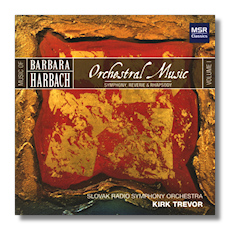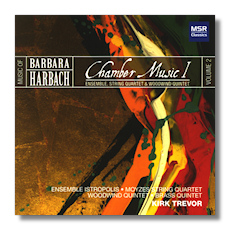
The Internet's Premier Classical Music Source
Related Links
- Harbach Reviews
- Latest Reviews
- More Reviews
-
By Composer
-
Collections
DVD & Blu-ray
Books
Concert Reviews
Articles/Interviews
Software
Audio
Search Amazon
Recommended Links
Site News
 CD Review
CD Review
Barbara Harbach

Orchestral Music
- Veneration
- Frontier Fancies
- Arcadian Rêverie
- Rhapsody "Jardine" for Oboe & Orchestra
- One of Ours "Willa Cather Symphony"
František Novotny, violin
Cynthia Green Libby, oboe
Slovak Radio Symphony Orchestra/Kirk Trevor
MSR Classics MS1252 2007 TT:56:05


Chamber Music I
- American Solstice
- Transformations for String Quartet
- Forces at Play
- Carondelet Caprice
- Separately Together - Synesthesia
- Rhapsody "Ritmico" for Brass Quintet
- Fantasy & Fugue on Swing Low Sweet Chariot for Woodwind Quartet
Moyzes String Quartet
Ensemble Istropolis/Kirk Trevor
MSR Classics MS1253 2007 65:32
Barbara Harbach has composed extensively in many forms, is a brilliant harpsichordist, and is a scholar of 18th-Century music, particularly of the work of women composers. She initiated a Women in the Arts program in St. Louis. Professor of Music at The University of Missouri-St. Louis, she studied at Penn State, Yale, the Musikhochschule in Frankfurt am Main, and the Eastman School of Music, from which she holds her doctorate. Be assured, though, that there is nothing "academic sounding" about her music.
In fact, Harbach's orchestral music is on the whole remarkably gentle and comfortable-sounding, even comforting – never fierce even when vigorous – and there is very little music I would put in such a category. Generally I go to music for aural excitement and I was initially put off just a bit when I did not find that here, but, as in the case of some quiet and gentle people, further acquaintance can reveal beautiful characteristics and come to be deeply satisfying.
Some of this music, notably Arcadian Rêverie and the Rhapsody Jardine for Oboe and String Orchestra, can be characterized as American pastoral. The massed string passages with gentle crescendos in the former actually reminded me a bit of Vaughan Williams' Tallis Fantasia, and the mood of the latter is not that far removed from RVWs Oboe Concerto, although neither work is in that composer's characteristic modal harmony. The oboe work does include a fugue and an off-beat waltz, so I hope my comparison is not too much of a stretch. Harbach likes fugues, not surprisingly in an 18th century scholar.
The other orchestral works are each in three movements. Veneration (with reference to Venus the goddess of love, beauty and desire) has a quiet, gentle and flowing opening, but with some intensity and release. The middle movement is an idyll that was to have been for cello and voice, according to the notes – unsigned but by Harbach; its treatment is fugal. The final movement is more propulsive, percussive and rhythmic, formally a rondo, and includes "all sorts of contrapuntal interplay based on an expansive rising melody."
The movements of Frontier Fancies are called Fiddleflirt, Twilight Dream, and Dancedevil. The music does not defeat the expectations these names will evoke. The outer movements are lively and rhythmic; the central one indeed dreamy.
One of Ours – A Cather Symphony was inspired by Willa Cather's 1922 Pulitzer prize winning novel about a World war I American war hero. Orchestrated with more use of winds and brass than the other works, the opening is pastoral, the middle movement lively and the finale, entitled Honor at Boar's Head, opens with a fanfare and has the most forceful music on the disc.
Initially, I found Harbach's chamber music more appealing than her orchestral pieces, which is unusual for me as I generally prefer orchestral music to all other kinds. The first piece on the disc, American Solstice, for a chamber ensemble consisting of a flute, clarinet, piano, double string quartet and bass, is wonderfully fresh, with sunny upbeat melody, making for far more than pleasant listening.
Three of these works were inspired by silent films from 1912 and 1913, two by the same director, Alice Guy Blanche. Transformations for String Quartet has eight movements, beginning with another Pastorale. Harbach says that it "captures a vein of folk Americana with moods ranging from nostalgia to agitation and resolution." Carondelet Caprice has a some comparable moods. Separately Together – Synesthesia "explores a variety of emotions and atmospheres that reflect the sensory images of the film" (A House Divided). The movement titles: Lilting Lines and Careening Melodies, Spattering Notes, Dancing Rhythms, Lyrical Re-vision and Crescendo of Colors, give a good summary.
Forces at Play, for flute, piccolo, clarinet, piano, violin, viola, cello and percussion, begins with a gorgeous theme, beautifully developed, a touch of which seemed to appear in the pastoral movement of the Cather Symphony and which reminded me of a similar theme Michael Kaman used in Mr. Holland's Opus. It runs about eleven minutes, approximately the length of most of these pieces.
Fantasy and Fugue on Swing Low, Sweet Chariot is another piece of Americana but with fugal treatment. The short Rhapsody Ritmico for Brass Quintet opens with a fanfare followed by a lullaby and a frolicking fugue.
The recording is good and the authoritative notes very welcome. A minor cavil is that the track numbers on the album (yellow on orange on dark green! on the chamber music album) are quite hard to make out. I strongly recommend both releases.
Copyright © 2008, R. James Tobin




















